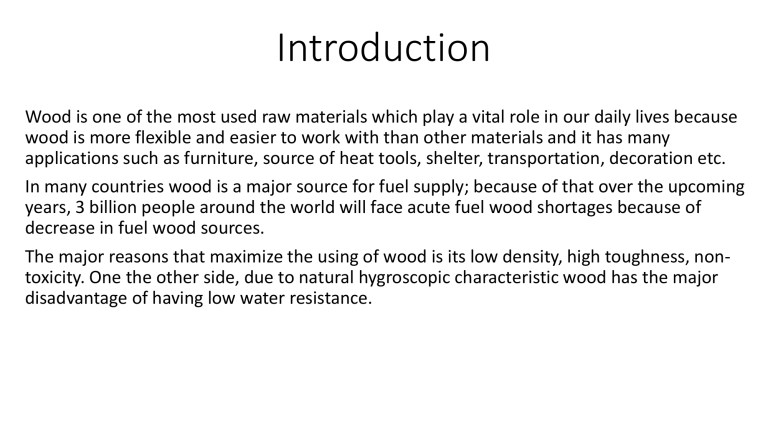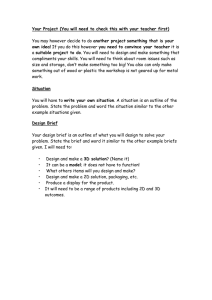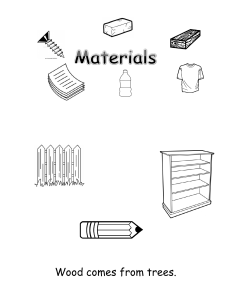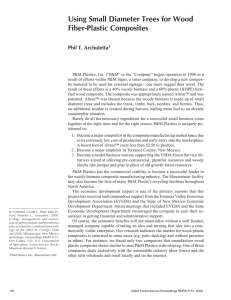
Introduction Wood is one of the most used raw materials which play a vital role in our daily lives because wood is more flexible and easier to work with than other materials and it has many applications such as furniture, source of heat tools, shelter, transportation, decoration etc. In many countries wood is a major source for fuel supply; because of that over the upcoming years, 3 billion people around the world will face acute fuel wood shortages because of decrease in fuel wood sources. The major reasons that maximize the using of wood is its low density, high toughness, nontoxicity. One the other side, due to natural hygroscopic characteristic wood has the major disadvantage of having low water resistance. • To reduce the use of wood in practical applications wood-plastic composites (WPC) are created. Also, because the source of the material for WPC can either be recycled or non-recycled WPC is an environmentally friendly material . • The reduction of waste or recycled materials in WPCs production process leads to reduction of the manufacturing costs and energy. Also, the use of recycled thermoplastics has increased in recent years but new or nonrecycled thermoplastic polymers are widely used in WPC manufacturing.. • In general, WPC has a production cost 15% more than pressure-treated lumber, on the other side it requires less maintenance cost. The actual payback period approximately 3 to 5 years compared to pressure-treated decking material. Its excellent dimensional stability along with less variability also can be considered as another advantage of WPC products. COMPOSITION OF WOOD PLASTIC • The concept of WPC, created in the 1970s and as its name, WPC is a material created from the blending of natural wood and plastic fibers. At these days, the concept is very known, and the term WPC refers to any composites material that contains plant fibers and thermoset or thermoplastic polymers The term wood–plastic composite is also known as wood–polymer composites WPCs contain polymers wood fibers and some additives • The two materials (plastic and wood) are mixed to create a homogenous relatively thick material, also at this stage, some additives are also combined, such as colorants, reinforcing agents, potentially fire retardants, and lubricants to achieve manufacturers’ specifications and a high level of specification for the intended products’ use. • Examples of wood–plastic composites made from different polymer types and wood elements are listed in Table Table 1: WPC types according to the polymer type WPCs Manufacturing Process • Wood-plastic composites (WPCs) are a combination of thermoplastic plastics and wood fibers. • The properties of the composite depend primarily on the plastic and wood content. • The main advantage of producing wood-plastic composites is the ability to use wasted plastics and woods as raw materials. • Any recycled plastic that could be processed below the degradation temperature of wood (lignocellulosic fillers) (200°C) is typically suitable for manufacturing WPCs. • Over 105 tons of fiber material per year can come from only one organization, better utilization of waste could be done even in a small-scale work environment. Material Used • WPCs are defined as composite materials (wood and thermoplastic materials). • The wood: - Used in various forms, in which a natural fiber and/or filler is mixed with the thermoplastic. - Natural fiber such as wood flour/fiber - Natural fibers present lower density, lower cost, less abrasiveness, and they are biodegradable and renewable. • The thermoplastic - The typical plastics used in this technology are various types of: 1- polyethylene (PE) (HDPE and LDPE) 2- polypropylene (PP) 3- polyvinyl chloride (PVC). Process consideration • Pellet size - The pellet size should be appropriate to achieve an excellent surface-tovolume ratio. - Dimensions are essential; because they facilitate drying and help to ensure a smooth flow throughout the production process. Moisture • Low moisture content is necessary to create high-quality plastics. • A properly designed manufacturing process can bear most of the burden of reducing the presence of moisture. • Once the water has entered into the material, it will leave only very slowly since the plastic provides a barrier to gas evaporation and, as a result, biodegradation may occur. • To avoid this issue a drying process should be done on the organic fillers before being added to the plastic. • Then, the composite must be dried again before being packaged; to avoid the onset of molding and eventual degradation of the composite. Processing Temperature • The processing temperature of plastics is high • whereas the heat resistance of natural fibers is limited, • So, the melting temperature of the thermoplastic fibers must be below the maximum heat resistance. (It usually resists heat in the range of 200-220°C.) • A discoloration and degraded plastic may result from the increased friction that burns the wood. • This friction was introduced due to melting wood-plastic composites at too high temperature, pushing the composite that is too hot through a too small die. Wood Particles Size • Smaller-sized particles will appear in the finished product like they were formed from a traditional plastic. • Larger-size wood particles will give the finished product a more wood-like appearance. The Ratio of Wood to Plastic • The percentage of wood in the composite affects: 1- The melt flow index (MFI), the more wood added, the lower the MFI. 2-The strength and stiffness of the product, the product becomes stiffer when more wood is added. 3- Machine cycle times • Due to high concentrations of wood, machine cycle times are shortened • by adding a component to the wood-plastic composite as it cools within the mold. • This structural reinforcement allows the plastic to be removed at a higher temperature than conventional plastic. At temperatures where conventional plastics are still too soft to be removed from their molds, composites made with wood can successfully be ejected. The Process • The beginning steps in WPC Fabrication 1-Logs, chips, and shavings of woods are collected. 2-Woods are crushed to powdered form (wood flour) using hammermill. 3-Blending of organic plant fibers with an inorganic thermoplastic Manufacturing Processes of WPCs 1-Extrusion 2-Injection molding 3-Compressing molding (also called thermoforming (pressing)) Extrusion Processes 1-Single screw - Is the simplest extrusion - system for producing WPC profiles. 2-Co-rotating twin screw - In combination with a hot melt single screw can be used to produce wood–plastic composite profiles. - No material preparation is required in terms of pre-blending components. 3-Counter-rotating twin screw Excel in applications where: - Heat-sensitive polymers like rigid polyvinyl chloride (PVC) are utilized - Low temperature extrusion for fibers and foams. - Non-compounded materials like powder blends. - Materials that are difficult to feed. - Those materials that require degassing. Injection Molding • Used to produce parts - containing complex geometries - requiring no finishing step. • It is limited compared to extrusion processing. Compression Molding or Thermoforming • Used in the manufacture of automobile composite parts. • WPC panels are produced. • Germany can produce continuous WPC sheets up to 1.3m wide and 13mm thick on a continuous basis. The Die and The Cooling Tank • The Die: • An important part of the WPC profile extrusion system. • It dictates the dimensions and profile (shape) of the extruded part. • Dies can be quite simple or complex depending on the desired profile. • The cooling tank • which is used to cool down the extruded profile in its linear shape. • It consists of a conveyer system with water spray heads that spray cool water on the profile extrudate. • The cooling tank may be 6 to 12 m long depending on the extruder material output and the cooling capacity required. • The water spray is typically recycled and may go through a chiller or heat exchanger to keep the spray water cool. • After the cooling tank, the WPC profile goes through a cut-off saw that can cut the lumber to the desired lengths. Properties of Wood Plastic Composites Wood Plastic Composites are known for their high molding performance since they can be easily molded to any shape and size including bent and arched shapes, and they have excellent dimensional stability. They are environmentally friendly Because they are made from recycled plastics and wasted woods collected mainly from wood industries Excellent splitting and cracking resistance That is why they are a good replacement for woods They have low maintenance costs compared to solid woods Wood plastics are known for the lack of need for paint because they are manufactured in a variety of colors and are widely available in grays and earth tones. Wood Plastic Composites are difficult to recycle Even though wood plastic composites are environmentally friendly they are difficult to recycle again after use because of all the polymers and adhesives added to this composite while making it Disadvantages of Wood Plastic Composites Fire Hazards The types of plastic normally used in WPC formulations have higher fire hazard properties than wood alone, as plastic has a higher chemical heat content and can melt, this problem can be solved by adding flame resistant materials into biomass particles and polymers during the compression, injection, and extrusion processes. Fungi Attacks When wood plastic composites are exposed to fungi this can decrease the esthetic quality and the appearance of the composite, tell now this problem can only be reduced by decreasing the percentage of wood if the product is used in places where fungal attacks and moisture are possible. Applications of Plastic Wood Why are plastic woods highly used? • Wood plastics contain a unique combination of advantages, being made up of wood and plastic we can get the best of both! • Consumers have started using wood-plastic composites with a motive to save the environment! As it is made with recyclable materials and leaves less hazardous waste. • It helps reduce deforestation, as the wood used in wood-plastic composite is a byproduct from the furniture industry. Why are plastic woods highly used? • Growing demand for high-performance, low-maintenance, and lowcost building products that are eco-friendly and offer maintenancefree properties is expected to fuel the global demand for wood-plastic composites in coming years. Can wood plastics become the new lumbar? • Wood plastics are being considered the real lumbar alternative depending on what material the sawdust is blended with — polyethylene or polypropylene — WPC can be used for a variety of construction projects in much the same way as natural lumber. • Drilling, planning, sanding; it’s all done just as easily with WPC as it is with wood. • Construction professionals may even find that wood fasteners, like nails and screws, actually achieve a better hold in WPC as compared to regular wood. Additionally, WPC is less likely to split or break when screws are used near the end of the planks, which can be a common problem when using real wood. Where are plastic woods used? The major applications of wood-plastic composites are building & construction products, followed by automotive components. Building and Construction • In building & construction applications, wood-plastic composites are widely used in decking, molding & sliding, and fencing • Two-thirds of the WPCs produced are decking and railing products, accounting for almost $1 billion annually. Automotive Components • The application of wood-plastic composites in automobiles is growing, due to the increasing awareness among customers about the various use and benefits. Automakers are focusing on making automobile parts either recyclable, or biodegradable. The incorporation of wood-plastic composite-based parts, which are recyclable or biodegradable, is expected to enhance mechanical strength and acoustic performance, reduce material weight and fuel consumption, lower production cost, improve passenger safety and shatterproof performance under extreme temperature changes, and improve biodegradability for the auto interior parts. Consumption of wood plastics • The building & construction products segment is expected to be the largest consumer of PE and PVC wood-plastic composites, followed by automotive components segment where wood-plastic composites are used for manufacturing lightweight automotive components.


